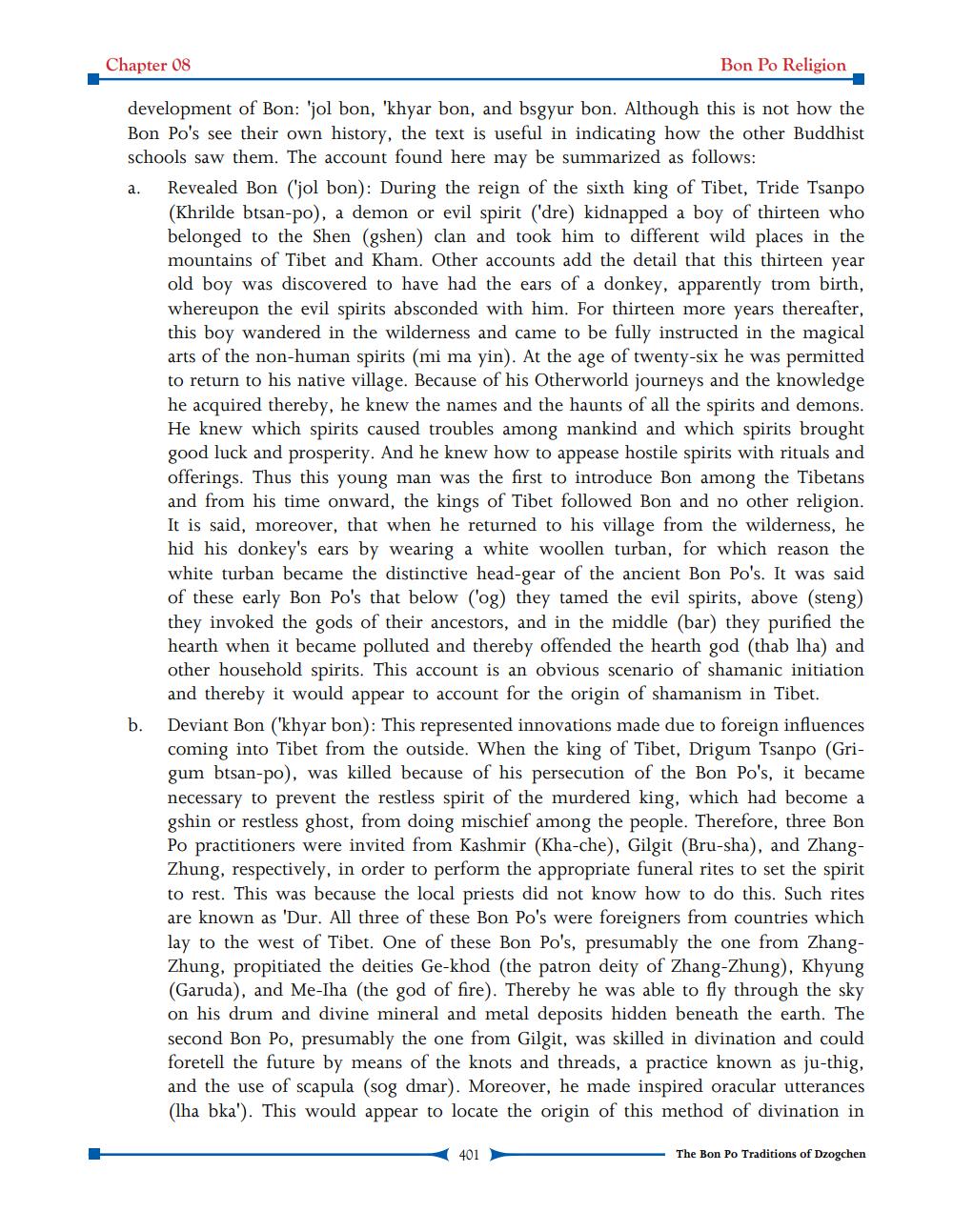________________
Chapter 08
Bon Po Religion
development of Bon: 'jol bon, "khyar bon, and bsgyur bon. Although this is not how the Bon Po's see their own history, the text is useful in indicating how the other Buddhist schools saw them. The account found here may be summarized as follows:
a.
Revealed Bon (jol bon): During the reign of the sixth king of Tibet, Tride Tsanpo (Khrilde btsan-po), a demon or evil spirit ('dre) kidnapped a boy of thirteen who belonged to the Shen (gshen) clan and took him to different wild places in the mountains of Tibet and Kham. Other accounts add the detail that this thirteen year old boy was discovered to have had the ears of a donkey, apparently trom birth, whereupon the evil spirits absconded with him. For thirteen more years thereafter, this boy wandered in the wilderness and came to be fully instructed in the magical arts of the non-human spirits (mi ma yin). At the age of twenty-six he was permitted to return to his native village. Because of his Otherworld journeys and the knowledge he acquired thereby, he knew the names and the haunts of all the spirits and demons. He knew which spirits caused troubles among mankind and which spirits brought good luck and prosperity. And he knew how to appease hostile spirits with rituals and offerings. Thus this young man was the first to introduce Bon among the Tibetans and from his time onward, the kings of Tibet followed Bon and no other religion. It is said, moreover, that when he returned to his village from the wilderness, he hid his donkey's ears by wearing a white woollen turban, for which reason the white turban became the distinctive head-gear of the ancient Bon Po's. It was said of these early Bon Po's that below ('og) they tamed the evil spirits, above (steng) they invoked the gods of their ancestors, and in the middle (bar) they purified the hearth when it became polluted and thereby offended the hearth god (thab lha) and other household spirits. This account is an obvious scenario of shamanic initiation and thereby it would appear to account for the origin of shamanism in Tibet.
b. Deviant Bon ('khyar bon): This represented innovations made due to foreign influences coming into Tibet from the outside. When the king of Tibet, Drigum Tsanpo (Grigum btsan-po), was killed because of his persecution of the Bon Po's, it became necessary to prevent the restless spirit of the murdered king, which had become a gshin or restless ghost, from doing mischief among the people. Therefore, three Bon Po practitioners were invited from Kashmir (Kha-che). Gilgit (Bru-sha), and ZhangZhung, respectively, in order to perform the appropriate funeral rites to set the spirit to rest. This was because the local priests did not know how to do this. Such rites are known as 'Dur. All three of these Bon Po's were foreigners from countries which lay to the west of Tibet. One of these Bon Po's, presumably the one from ZhangZhung, propitiated the deities Ge-khod (the patron deity of Zhang-Zhung), Khyung (Garuda), and Me-Iha (the god of fire). Thereby he was able to fly through the sky on his drum and divine mineral and metal deposits hidden beneath the earth. The second Bon Po, presumably the one from Gilgit, was skilled in divination and could foretell the future by means of the knots and threads, a practice known as ju-thig, and the use of scapula (sog dmar). Moreover, he made inspired oracular utterances (lha bka). This would appear to locate the origin of this method of divination in
401
The Bon Po Traditions of Dzogchen




